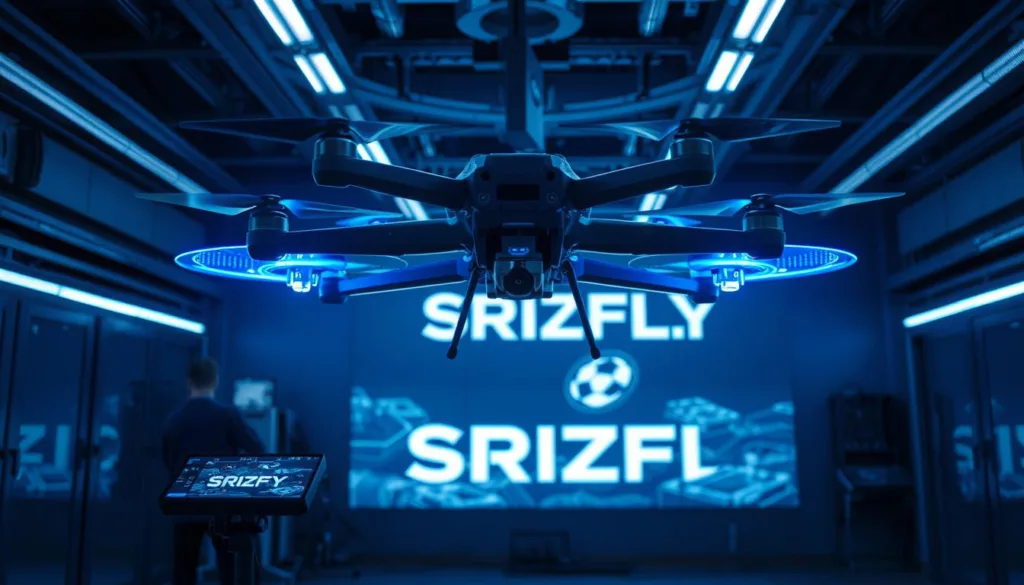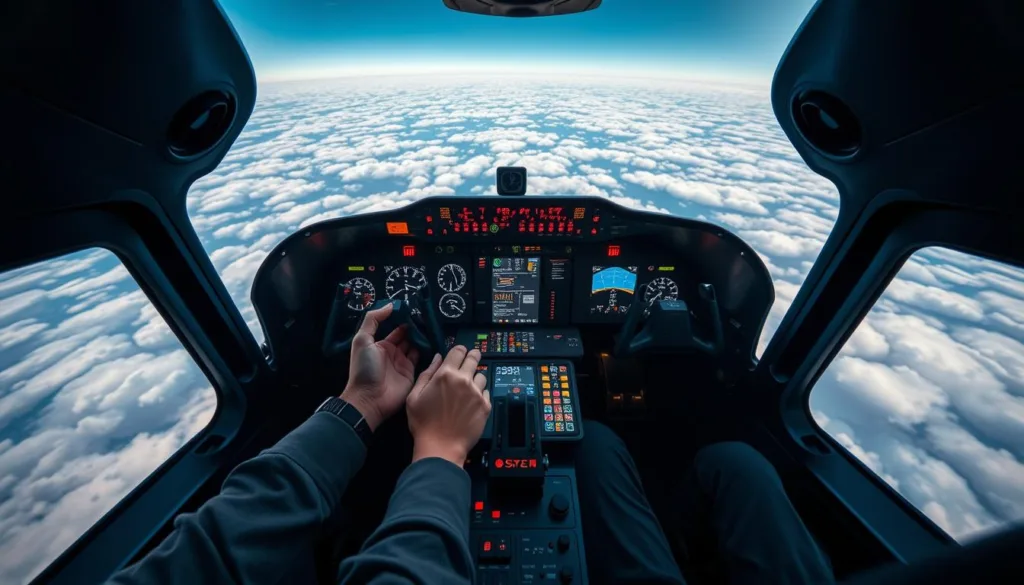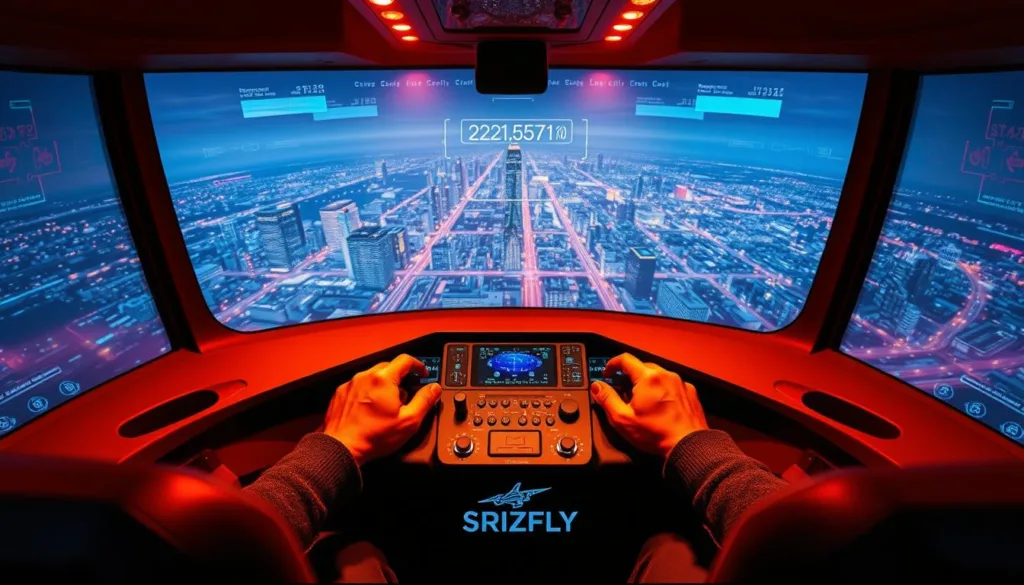Educational institutions now have access to next-generation tools for teaching unmanned aerial systems. SRIZFLY’s flight simulation technology creates a risk-free environment where learners master practical skills through realistic scenarios. This approach reduces costs by up to 70% compared to traditional methods while maintaining rigorous safety standards.
Our system bridges classroom theory and real-world application. Students interact with software that mimics wind patterns, equipment malfunctions, and complex navigation challenges. Instructors gain detailed performance analytics to personalize lessons and track progress effectively.
Built on aviation industry protocols, these programs prepare learners for careers in fields like infrastructure inspection and aerial photography. Schools can launch courses faster using turnkey resources that meet Federal Aviation Administration guidelines. The modular design allows customization for different skill levels and industry needs.
Key Takeaways
- Flight simulators cut operational costs while enhancing safety protocols
- Real-time performance tracking helps educators refine teaching strategies
- Modular programs adapt to various unmanned system applications
- FAA-aligned coursework meets commercial sector requirements
- Scalable solutions support institutions at any implementation stage
Innovative Drone Training Curriculum
Modern classrooms are transforming into flight labs with interactive simulation systems that spark curiosity. These tools let learners explore aerial navigation principles through trial and error, building confidence before handling physical equipment.

Advanced Simulation Technology
Our platform replicates real-world physics with stunning accuracy. Wind resistance, battery drain, and emergency protocols become tangible learning moments. Elementary learners start with basic lift/drag concepts, while high schoolers tackle:
- Autonomous route planning
- Obstacle avoidance algorithms
- Data collection missions
The system adapts to different age groups seamlessly. Third graders might program simple flight patterns, while twelfth graders solve complex engineering puzzles. “It’s like having a flight instructor available 24/7,” notes a participating STEM coordinator.
Affordable and Risk-Free Training Solutions
Schools save thousands annually by reducing equipment wear-and-tear. Our virtual environment offers:
- Unlimited practice sessions
- Instant performance feedback
- Customizable weather scenarios
Educators appreciate how these resources align with Next Generation Science Standards. A middle school teacher recently shared: “We went from zero to full program in three weeks – students are coding autonomous missions already.”
This approach makes aviation education accessible to all districts. Rural schools particularly benefit from the budget-friendly alternative to expensive hardware. Students gain marketable skills while schools maintain strict safety protocols.
Enhancing Student Engagement through Simulated Flight
Interactive aviation education transforms how young minds grasp STEM principles. Our platform turns abstract ideas into tangible experiences where learners see physics in action through virtual aircraft operations. This method sparks curiosity while building technical proficiency.

Providing Hands-On Learning Experiences
Students manipulate virtual aircraft systems to understand aerodynamics fundamentals. Real-time feedback shows how adjustments affect performance:
| Traditional Learning | Simulated Approach |
|---|---|
| Passive textbook study | Active problem-solving |
| Limited practice time | Unlimited trial scenarios |
| Theoretical knowledge | Applied engineering skills |
Middle schoolers recently programmed autonomous routes using wind resistance data. “They grasped lift/drag ratios faster through simulation than months of lectures,” reports a Texas STEM teacher.
Bridging the Gap Between Theory and Practice
Learners test hypotheses in safe digital environments. A seventh grader explained: “When I changed wing angles, the software showed exactly why my design failed.” This immediate cause-effect understanding strengthens retention.
Educators appreciate how virtual scenarios prepare students for real-world challenges. One program lets learners:
- Calculate battery life during mapping missions
- Troubleshoot navigation errors
- Optimize flight paths using weather data
Schools save 83% on equipment costs while delivering professional-grade aviation education. Students gain marketable skills in automation and systems thinking – critical for tomorrow’s tech careers.
Integrating FAA Part 107 and STEM Opportunities
Schools now bridge regulatory expertise with technical education through programs meeting federal aviation standards. Our solution combines certification prep with practical STEM applications, creating pathways for tomorrow’s aviation professionals.
FAA Part 107: Ensuring Safe and Compliant Flight
The Remote Pilot Certificate opens doors for commercial operations nationwide. Students aged 16+ master:
- Airspace classification systems
- Weather impact analysis
- Emergency protocol execution
Our courses cover 100% of the FAA’s UAG exam content. Learners practice night operations and radio communications through simulations that mirror real-world challenges. “Graduates enter the workforce ready to pass certification tests on their first attempt,” shares a program coordinator.
Embedding STEM and Engineering Concepts
Math and physics principles come alive through aviation scenarios. Students calculate battery life during mapping missions and troubleshoot navigation errors using engineering logic. This approach builds:
- Critical thinking skills
- Data analysis proficiency
- Systems design understanding
Empowering Instructors with Professional Development
Educators receive specialized resources for teaching aviation concepts effectively. Our professional development program includes:
- Lesson plan templates
- Progress tracking tools
- Recurrent training modules
Teachers gain confidence using simulation technology while meeting Next Generation Science Standards. One instructor noted: “The support materials helped me transition from textbook lessons to hands-on aviation instruction in three weeks.”
Conclusion
Aviation education is entering a new era of accessibility and impact. SRIZFLY’s simulation-based programs give schools complete STEM solutions that spark curiosity while building technical expertise. Learners master essential concepts through realistic scenarios that mirror real-world aviation challenges.
Our approach prepares students for high-demand careers in commercial operations and engineering fields. The system aligns with FAA guidelines, ensuring graduates understand airspace rules and safety protocols. Instructors get turnkey resources to teach complex topics effectively.
Schools across the U.S. are using these tools to create pathways into growing industries. Students gain hands-on experience with navigation systems and problem-solving techniques valued by employers. The platform’s flexibility allows customization for different age groups and learning objectives.
Ready to elevate your STEM program? Let’s explore how our solutions can meet your institution’s needs while preparing learners for tomorrow’s opportunities. Contact us today to discuss implementation strategies that fit your budget and educational goals.
FAQ
How does SRIZFLY prepare students for the FAA Part 107 exam?
Our programs integrate FAA Part 107 requirements into every lesson, covering airspace rules, weather patterns, and operational safety. Interactive simulations and practice tests ensure learners grasp key concepts for passing the certification.
What makes simulated flight technology effective for learning?
Advanced simulations replicate real-world scenarios, allowing practice in controlled environments. This reduces risks, lowers costs, and builds confidence before actual flights. It also helps bridge theoretical knowledge with practical skills.
Are STEM concepts part of the program?
Yes! We embed STEM and engineering principles, like aerodynamics and data analysis, into lessons. This prepares students for careers in aviation, robotics, or related fields while fostering critical thinking.
Is this program affordable for schools or individuals?
Absolutely. By using virtual tools, we eliminate expenses tied to physical equipment. Schools can access scalable solutions, and individuals gain industry-ready skills without high upfront costs.
How do instructors stay updated with industry standards?
SRIZFLY offers professional development workshops, including updates on FAA regulations and teaching strategies. Instructors receive resources to keep lessons aligned with evolving aviation trends.
Can beginners succeed without prior aviation experience?
Our curriculum starts with foundational topics, like airspace classification and flight mechanics. Step-by-step modules and instructor support ensure all learners build competence, regardless of their background.



